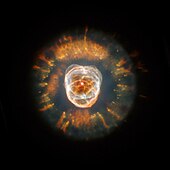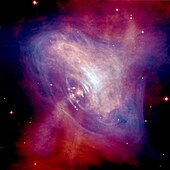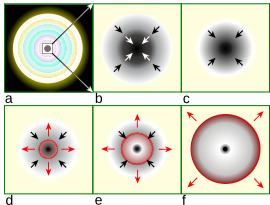Compact object
Inastronomy,the termcompact object(orcompact star) refers collectively towhite dwarfs,neutron stars,andblack holes.It could also includeexotic starsif such hypothetical, dense bodies are confirmed to exist. All compact objects have a highmassrelative to their radius, giving them a very highdensity,compared to ordinaryatomicmatter.
Compact objects are often the endpoints ofstellar evolutionand, in this respect, are also calledstellar remnants.The state and type of a stellar remnant depends primarily on the mass of the star that it formed from. The ambiguous termcompact objectis often used when the exact nature of the star is not known, but evidence suggests that it has a very smallradiuscompared to ordinarystars.A compact object that is not a black hole may be called adegenerate star.
In June 2020, astronomers reported narrowing down the source ofFast Radio Bursts(FRBs), which may now plausibly include "compact-object mergers andmagnetarsarising from normal core collapsesupernovae".[1][2]
Formation
[edit]The usual endpoint ofstellar evolutionis the formation of a compact star.
All active stars will eventually come to a point in their evolution when the outward radiation pressure from the nuclear fusions in its interior can no longer resist the ever-present gravitational forces. When this happens, the star collapses under its own weight and undergoes the process ofstellar death.For most stars, this will result in the formation of a very dense and compact stellar remnant, also known as a compact star.
Compact objects have no internal energy production, but will—with the exception of black holes—usually radiate for millions of years with excess heat left from the collapse itself.[3]
According to the most recent understanding, compact stars could also form during thephase separationsof the early Universe following theBig Bang.[4]Primordial origins of known compact objects have not been determined with certainty.
Lifetime
[edit]Although compact objects may radiate, and thus cool off and lose energy, they do not depend on high temperatures to maintain their structure, as ordinary stars do. Barring external disturbances andproton decay,they can persist virtually forever.Black holesare however generally believed to finally evaporate fromHawking radiationafter trillions of years. According to our current standard models ofphysical cosmology,all stars will eventually evolve into cool and dark compact stars, by the time the Universe enters the so-calleddegenerate erain a very distant future.
A somewhat wider definition ofcompact objectsmay includesmaller solid objectssuch asplanets,asteroids,andcomets,but such usage is less common. There are a remarkable variety of stars and other clumps of hot matter, but all matter in the Universe must eventually end as dispersed cold particles or some form of compact stellar or substellar object, according tothermodynamics.
White dwarfs
[edit]
The stars calledwhite or degenerate dwarfsare made up mainly ofdegenerate matter;typically carbon and oxygen nuclei in a sea of degenerate electrons. White dwarfs arise from the cores ofmain-sequence starsand are therefore very hot when they are formed. As they cool they will redden and dim until they eventually become darkblack dwarfs.White dwarfs were observed in the 19th century, but the extremely high densities and pressures they contain were not explained until the 1920s.
Theequation of statefor degenerate matter is "soft", meaning that adding more mass will result in a smaller object. Continuing to add mass to what begins as a white dwarf, the object shrinks and the central density becomes even greater, with higher degenerate-electron energies. After the degenerate star's mass has grown sufficiently that its radius has shrunk to only a few thousand kilometers, the mass will be approaching theChandrasekhar limit– the theoretical upper limit of the mass of a white dwarf, about 1.4 times themass of the Sun(M☉).
If matter were removed from the center of a white dwarf and slowly compressed, electrons would first be forced to combine with nuclei, changing theirprotonstoneutronsbyinverse beta decay.The equilibrium would shift towards heavier, neutron-richer nuclei that are not stable at everyday densities. As the density increases, these nuclei become still larger and less well-bound. At a critical density of about 4×1014kg/m3– called theneutron drip line– the atomic nucleus would tend to dissolve into unbound protons and neutrons. If further compressed, eventually it would reach a point where the matter is on the order of the density of an atomic nucleus – about 2×1017kg/m3.At that density the matter would be chiefly free neutrons, with a light scattering of protons and electrons.
Neutron stars
[edit]
In certainbinary starscontaining a white dwarf, mass is transferred from the companion star onto the white dwarf, eventually pushing it over theChandrasekhar limit.Electrons react with protons to form neutrons and thus no longer supply the necessary pressure to resist gravity, causing the star to collapse. If the center of the star is composed mostly of carbon and oxygen then such agravitational collapsewill ignite runaway fusion of the carbon and oxygen, resulting in aType Ia supernovathat entirely blows apart the star before the collapse can become irreversible. If the center is composed mostly of magnesium or heavier elements, the collapse continues.[5][6][7]As the density further increases, the remaining electrons react with the protons to form more neutrons. The collapse continues until (at higher density) the neutrons become degenerate. A new equilibrium is possible after the star shrinks by threeorders of magnitude,to a radius between 10 and 20 km. This is aneutron star.
Although the first neutron star was not observed until 1967 when the first radiopulsarwas discovered, neutron stars were proposed by Baade and Zwicky in 1933, only one year after the neutron was discovered in 1932. They realized that because neutron stars are so dense, the collapse of an ordinary star to a neutron star would liberate a large amount ofgravitational potential energy,providing a possible explanation forsupernovae.[8][9][10]This is the explanation for supernovae of typesIb, Ic,andII.Such supernovae occur when the iron core of a massive star exceeds the Chandrasekhar limit and collapses to a neutron star.
Like electrons, neutrons arefermions.They therefore provideneutron degeneracy pressureto support a neutron star against collapse. In addition, repulsive neutron-neutron interactions[citation needed]provide additional pressure. Like the Chandrasekhar limit for white dwarfs, there is a limiting mass for neutron stars: theTolman–Oppenheimer–Volkoff limit,where these forces are no longer sufficient to hold up the star. As the forces in dense hadronic matter are not well understood, this limit is not known exactly but is thought to be between 2 and 3M☉.If more mass accretes onto a neutron star, eventually this mass limit will be reached. What happens next is not completely clear.
Black holes
[edit]
As more mass is accumulated, equilibrium against gravitational collapse exceeds its breaking point. Once the star's pressure is insufficient to counterbalance gravity, a catastrophic gravitational collapse occurs within milliseconds. Theescape velocityat the surface, already at least1⁄3light speed, quickly reaches the velocity of light. At that point no energy or matter can escape and ablack holehas formed. Because all light and matter is trapped within anevent horizon,a black hole appears trulyblack,except for the possibility of very faintHawking radiation.It is presumed that the collapse will continue inside the event horizon.
In the classical theory ofgeneral relativity,agravitational singularityoccupying no more than apointwill form. There may be a new halt of the catastrophic gravitational collapse at a size comparable to thePlanck length,but at these lengths there is no known theory of gravity to predict what will happen. Adding any extra mass to the black hole will cause the radius of the event horizon to increase linearly with the mass of the central singularity. This will induce certain changes in the properties of the black hole, such as reducing the tidal stress near the event horizon, and reducing the gravitational field strength at the horizon. However, there will not be any further qualitative changes in the structure associated with any mass increase.
Alternative black hole models
[edit]- Fuzzball[11]
- Gravastar[11]
- Dark-energy star
- Black star
- Magnetospheric eternally collapsing object
- Dark star[11]
- Primordial black holes
Exotic stars
[edit]Anexotic staris a hypothetical compact star composed of something other thanelectrons,protons,andneutronsbalanced againstgravitational collapsebydegeneracy pressureor other quantum properties. These includestrange stars(composed ofstrange matter) and the more speculativepreon stars(composed ofpreons).
Exotic stars are hypothetical, but observations released by theChandra X-Ray Observatoryon April 10, 2002, detected two candidate strange stars, designatedRX J1856.5-3754and3C58,which had previously been thought to be neutron stars. Based on the known laws of physics, the former appeared much smaller and the latter much colder than they should, suggesting that they are composed of material denser thanneutronium.However, these observations are met with skepticism by researchers who say the results were not conclusive.[citation needed]
Quark stars and strange stars
[edit]If neutrons are squeezed enough at a high temperature, they will decompose into their componentquarks,forming what is known as aquark matter.In this case, the star will shrink further and become denser, but instead of a total collapse into a black hole, it is possible that the star may stabilize itself and survive in this state indefinitely, so long as no more mass is added. It has, to an extent, become a very largenucleon.A star in this hypothetical state is called a "quark star"or more specifically a" strange star ". The pulsar3C58has been suggested as a possible quark star. Most neutron stars are thought to hold a core of quark matter but this has proven difficult to determine observationally.[citation needed]
Preon stars
[edit]Apreon staris aproposedtype of compact star made ofpreons,a group ofhypotheticalsubatomic particles.Preon stars would be expected to have hugedensities,exceeding 1023kilogram per cubic meter – intermediate between quark stars and black holes. Preon stars could originate from supernova explosions or theBig Bang;however, current observations from particle accelerators speak against the existence of preons.[citation needed]
Q stars
[edit]Q starsare hypothetical compact, heavier neutron stars with an exotic state of matter where particle numbers are preserved with radii less than 1.5 times the correspondingSchwarzschild radius.Q stars are also called "gray holes".
Electroweak stars
[edit]Anelectroweak staris a theoretical type of exotic star, whereby the gravitational collapse of the star is prevented byradiation pressureresulting fromelectroweak burning,that is, the energy released by conversion ofquarkstoleptonsthrough theelectroweak force.This process occurs in a volume at the star's core approximately the size of anapple,containing about two Earth masses.[12]
Boson star
[edit]Aboson staris a hypotheticalastronomical objectthat is formed out of particles calledbosons(conventionalstarsare formed out offermions). For this type of star to exist, there must be a stable type of boson with repulsive self-interaction. As of 2016 there is no significant evidence that such a star exists. However, it may become possible to detect them by the gravitational radiation emitted by a pair of co-orbiting boson stars.[13][14]
Compact relativistic objects and the generalized uncertainty principle
[edit]Based on thegeneralized uncertainty principle(GUP), proposed by some approaches to quantum gravity such asstring theoryanddoubly special relativity,the effect of GUP on the thermodynamic properties of compact stars with two different components has been studied recently.[15]Tawfik et al. noted that the existence of quantum gravity correction tends to resist the collapse of stars if the GUP parameter is taking values between Planck scale and electroweak scale. Comparing with other approaches, it was found that the radii of compact stars should be smaller and increasing energy decreases the radii of the compact stars.
See also
[edit]References
[edit]- ^Starr, Michelle (1 June 2020)."Astronomers Just Narrowed Down The Source of Those Powerful Radio Signals From Space".ScienceAlert.com.Retrieved2 June2020.
- ^Bhandan, Shivani (1 June 2020)."The Host Galaxies and Progenitors of Fast Radio Bursts Localized with the Australian Square Kilometre Array Pathfinder".The Astrophysical Journal Letters.895(2): L37.arXiv:2005.13160.Bibcode:2020ApJ...895L..37B.doi:10.3847/2041-8213/ab672e.S2CID218900539.
- ^Tauris, T. M.; J. van den Heuvel, E. P. (20 Mar 2003).Formation and Evolution of Compact Stellar X-ray Sources.arXiv:astro-ph/0303456.Bibcode:2006csxs.book..623T.
- ^Khlopov, Maxim Yu. (June 2010). "Primordial black holes".Research in Astronomy and Astrophysics.10(6): 495–528.arXiv:0801.0116.Bibcode:2010RAA....10..495K.doi:10.1088/1674-4527/10/6/001.S2CID14466173.
- ^ Hashimoto, M.; Iwamoto, K.; Nomoto, K. (1993)."Type II supernovae from 8–10 solar mass asymptotic giant branch stars".The Astrophysical Journal.414:L105.Bibcode:1993ApJ...414L.105H.doi:10.1086/187007.
- ^ Ritossa, C.; Garcia-Berro, E.; Iben, I. Jr. (1996)."On the Evolution of Stars That Form Electron-degenerate Cores Processed by Carbon Burning. II. Isotope Abundances and Thermal Pulses in a 10 MsunModel with an ONe Core and Applications to Long-Period Variables, Classical Novae, and Accretion-induced Collapse ".The Astrophysical Journal.460:489.Bibcode:1996ApJ...460..489R.doi:10.1086/176987.
- ^ Wanajo, S.; et al. (2003). "The r-Process in Supernova Explosions from the Collapse of O-Ne-Mg Cores".The Astrophysical Journal.593(2): 968–979.arXiv:astro-ph/0302262.Bibcode:2003ApJ...593..968W.doi:10.1086/376617.S2CID13456130.
- ^Osterbrock, D. E. (2001). "Who Really Coined the Word Supernova? Who First Predicted Neutron Stars?".Bulletin of the American Astronomical Society.33:1330.Bibcode:2001AAS...199.1501O.
- ^ Baade, W.; Zwicky, F. (1934)."On Super-Novae".Proceedings of the National Academy of Sciences.20(5): 254–9.Bibcode:1934PNAS...20..254B.doi:10.1073/pnas.20.5.254.PMC1076395.PMID16587881.
- ^ Baade, W.; Zwicky, F. (1934)."Cosmic Rays from Super-Novae".Proceedings of the National Academy of Sciences.20(5): 259–263.Bibcode:1934PNAS...20..259B.doi:10.1073/pnas.20.5.259.PMC1076396.PMID16587882.
- ^abcVisser, M.; Barcelo, C.; Liberati, S.; Sonego, S. (2009). "Small, dark, and heavy: But is it a black hole?".arXiv:0902.0346[gr-qc].
- ^ Shiga, D. (4 January 2010)."Exotic stars may mimic big bang".New Scientist.Retrieved2010-02-18.
- ^Schutz, Bernard F. (2003).Gravity from the ground up(3rd ed.).Cambridge University Press.p.143.ISBN0-521-45506-5.
- ^Palenzuela, C.; Lehner, L.; Liebling, S. L. (2008). "Orbital dynamics of binary boson star systems".Physical Review D.77(4): 044036.arXiv:0706.2435.Bibcode:2008PhRvD..77d4036P.doi:10.1103/PhysRevD.77.044036.S2CID115159490.
- ^Ahmed Farag Ali and A. Tawfik,Int. J. Mod. Phys. D22 (2013) 1350020
Sources
[edit]- Blaschke, D.; Fredriksson, S.; Grigorian, H.; Öztaş, A.; Sandin, F. (2005). "Phase diagram of three-flavor quark matter under compact star constraints".Physical Review D.72(6): 065020.arXiv:hep-ph/0503194.Bibcode:2005PhRvD..72f5020B.doi:10.1103/PhysRevD.72.065020.S2CID119356279.
- Sandin, F. (2005). "Compact stars in the standard model – and beyond".European Physical Journal C.40(2): 15–22.arXiv:astro-ph/0410407.Bibcode:2005EPJC...40...15S.doi:10.1140/epjcd/s2005-03-003-y.S2CID119495444.
- Sandin, F. (2005).Exotic Phases of Matter in Compact Stars(PDF)(Thesis).Luleå University of Technology.



